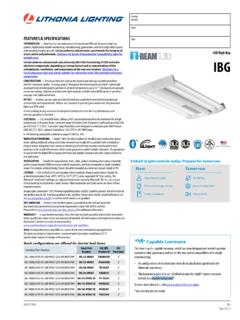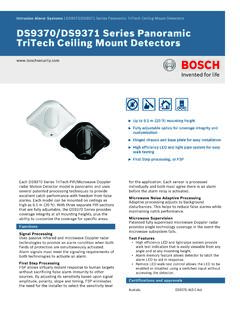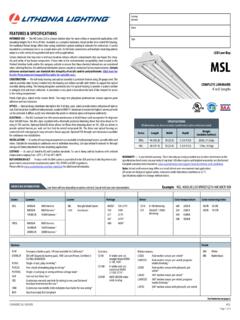Transcription of Wireless Sensors for Lighting Energy Savings
1 Wireless Sensors for Lighting Energy SavingsFEDERAL Energy MANAGEMENT PROGRAM Wireless Occupancy Sensors for Lighting Controls: An Applications Guide for Federal Facility Managers Lighting use constitutes about 20% of the total Energy consumption in commercial Adding Lighting controls is a simple retrofit option than can save on Energy costs while help-ing to meet agency and federal Energy Savings mandates. Some Energy codes and federal standards require the use of Lighting controls (see Lighting Controls in Codes and Standards on page 7). How Much Can You Expect to Save When You Install Occupancy sensor Lighting Controls in These Rooms? Room Occupancy sensor Type Lighting Energy Savings2 Breakroom 29% 40-46% 45% 30-80% 13-50% 10% 30-90% 45-80% 35-54% Classroom Conference Room Corridor Ofce, Private Ofce, Open Restroom Storage Area Warehouse Occupancy Sensors increase Lighting Energy Savings by turning of or turning down the lights when rooms are unoccupied.
2 Lighting Energy Savings of 10% to 90% are possible depending on room usage. Photo courtesy of Pacifc Northwest National Laboratory. Lighting controls that reduce or turn off the Lighting when a space is not in use can save a significant amount of Energy . Studies have shown that adding Lighting controls can reduce Lighting Energy use 10% to 90% or more depending on the use of the space in which the Sensors are installed. One study conducted on a university campus found that installing wired occupancy Sensors to control Lighting in more than 200 rooms in 10 buildings provided an annual cost Savings of about $14,000 with a simple payback of Although many of the Sensors installed in facilities are hard wired, Wireless Sensors that use radio frequency to communicate with Lighting fixtures are a viable option. These lightweight, battery- or solar-powered Sensors can be attached to the wall anywhere with Velcro, magnets, or screws because no electric wiring is necessary.
3 This means they can be installed where wiring would be impractical or impossible to install. It also means a significant reduction in labor installation cost. Another benefit is future flexibility it s easy to move them if the room usage or configuration changes. Calibrate and recalibrate to perfect operation Set appropriatecontrol parameters Choose mountinglocation and orientation Choose appropriate spaces Choose the right sensor product Follow these fve steps for successful installation of Wireless Sensors . Anatomy of a Passive Infrared sensor The solid-state passive infrared sensor consists of thin-flm pyroelectric heat-sensing material mounted on a printed circuit board containing the necessary electronics to interpret the signals from the sensor . When a warm object like a person passes by, the sensor detects the heat, which causes a positive diferential change between the two halves of the sensor .
4 When the warm body leaves the sensing area, the sensor generates a negative diferential change. These change pulses are what is detected. The assembly is contained in a housing with a plastic window that allows in infrared radiation. The window itself may be molded plastic that is faceted. Each facet is a Fresnel lens that focuses the infrared Energy or there might be segmented parabolic mirrors within the house that focus the infrared Energy . The window plastic can also serve as a flter to limit the wavelengths to 8-14 micrometers, which is closest to the infrared radiation emitted by humans, to minimize false positives. FEDERAL Energy MANAGEMENT PROGRAM 2 Luminaire Manual switch Luminaire Controller sensor Manual switch Luminaire Controller with manual switch sensor Manual switch Sensors installed in a room to control Lighting can be wired or Wireless .
5 Where Should I Use Them? Occupancy-driven Lighting controls, whether wired or Wireless , are cost effective in locations that are used intermittently, like stairwells, breakrooms, conference rooms, and restrooms. Offices, which are becoming more intermittently occupied with the rise of telecommuting, can be a good candidate for occupancy Sensors . Other good locations are classrooms, laboratories, warehouses, parking garages and parking lots. They are less likely to be cost effective in open office areas or busy lobby areas that have occupant traffic throughout the day. Spaces that have steady occupancy during the day and are unoccupied at night on a predictable schedule may be better served by timer-based Lighting controls. Sensors can be used for two types of Lighting control strategies: Occupancy Sensors (auto on/auto off). With this strategy, the sensor automatically turns on the lights when someone enters the space and turns off the lights after a user-designated time period if no movement is detected.
6 Vacancy Sensors (manual on/auto off). With this strategy, the person entering the room manually switches on the lights. If they are left on when the person leaves the room, after a certain amount of time with no movement, the sensor will turn off the lights. Vacancy Sensors could potentially yield greater Energy Savings than occupancy Sensors because they give the occupant a choice of whether or not to turn on the lights. If there is enough ambient light, for example from daylight entering through windows, the occupant may choose not to turn on the lights at all, whereas with LuminaireLuminaire Controller sensor the occupancy sensor , the lights will come on automatically regardless of how much daylight is in the room. Vacancy Sensors work well in most types of rooms with daylighting, including offices and conference rooms. They can work well in other rooms with light switches near each entry.
7 Vacancy Sensors are not recommended for areas where there are many entries that do not have light switches like stairwells, corridors, or warehouses. In addition, they do not work well for areas where some level of Lighting is needed immediately, like stairwells and mechanical rooms, unless the controls are set to dim but not turn off the lights during hours of expected use. Vacancy Sensors may not be appropriate in spaces where there is a code requirement for a minimum level of light at all times. Occupancy Sensors work well with all room types but Savings will be greatest with rooms that do not have windows or other sources of ambient light, like break rooms and restrooms. How Do They Work? An occupancy sensor detects the presence of movement within its given range. The sensor detects motion and transmits the signal to the control unit. If no movement is detected after a period of time set by the user, the controller determines the space is unoccupied and switches off the light.
8 The control unit processes signals from the sensor to increase or decrease power to the light fixture. In a Wireless occupancy sensor , the sensor sends a Wireless signal to the controller, and the controller increases or decreases the power to the luminaire. Signal repeaters can be installed if the signal has to be relayed more than 50 feet from the sensor to the controller. Controllers need to be connected at the junction box (except for controllers that are part of a wall switch). The two most common types of occu-pancy Sensors are passive infrared and ultrasonic Sensors but other types are also used. Passive Infrared (PIR) ( Wireless ) PIR Sensors are typically used in small, enclosed spaces to detect major motions such as occupants moving in and out of a room. They are less adept at picking up small movements like sitting at a desk typing. They have a nominal limit of about 15 feet (but lower mounting heights might be more practical) and the sensor must have direct line of sight with the focal length sensor Infrared Radiation VCC VIR R + + --Fresnel Lens Comparison of Ultrasonic and PIR Ceiling-Mounted Occupancy Sensors The PIR sensor , which could be wired or Wireless , has a smaller coverage pattern (depicted by the light blue and darker blue cones) while the ultrasonic sensor , which is only available as a hard-wired system, has the larger coverage area (depicted by the gray rectangles).
9 FEDERAL Energy MANAGEMENT PROGRAM Description3 Explore other Control Strategies Explore other Control Strategies Wireless sensor Wired sensor Wired sensor No Yes No No Yes No Yes No Yes No Yes No Yes No Yes No Yes No Yes No Yes No Yes No Yes No Yes Yes Is the space used unpredicta ly and intermittently, and are the lights left on when unoccupied? Are there Energy code compliance requirements? Does the space contain large partitions? Are there defned space oundaries? Is there moving mechanical equipment in the space? Explore other Control Strategies Can a smaller control zone e esta lished for Lighting control? Would you like occupancy- ased controls? Can small/more specifc areas e controlled? Does the space containlarge partitions? Would the installation of Sensors result in reasona le pay ack? Is there clear line of sight toall areas?
10 Is there an appropriatemounting locationaway fromthe airfow? Is the ceiling higher than 12 ft or curved or slanted? Is there high volume airfow in the space? Which Technology Is Best for Your Space? Use this decision tree to determine which Lighting control technology is better for a given room - Wireless Sensors or wired Sensors . less. Ultrasonic Sensors are well suited for spaces requiring a higher level of sensitiv-ity and/or where a clear line of sight is not possible because of partitions, tall furniture ( , bookcases), odd-shaped rooms, bath-room stalls, etc. Ultrasonic Sensors have moving object to detect movement. They should not be mounted close to HVAC supply registers, which can disrupt their detection. PIR Sensors have a thin film sensing material that generates electricity when exposed to heat. When an object passes in front of a background like a wall or the ground, the sensor detects the change in signal and converts that change into a pulse that sends a signal to a controller for a light.
















